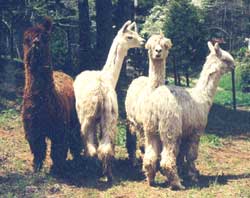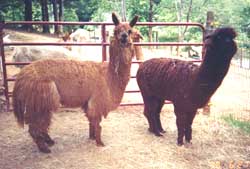History of the Alpaca

More than 5,000 years ago, the Incan empire stretched some 2,500 miles along the mountainous Andean range. Alpacas were cherished by the Incan empire and considered a great source of wealth. The fiber from the Alpacas was uniquely suited to protect the Incas in their hostile environment. The exquisite cashmere-like fleece that is produced from alpacas was once reserved for Inca royalty. This amazing animal had the ability to live in extremely high elevations and under harsh conditions where other domestic animals could not survive.
But soon the survival of the alpacas would be put through an amazing challenge. The Incan empire was seriously threatened for the first time by the hands of the Spanish Conquistadors in the 1500's. Much of the "conquest" was however, accomplished without battles or warfare. Instead, infectious diseases left devastating marks on New World Indian cultures. In particular, smallpox spread quickly through Panama, eradicating entire populations. Once the disease crossed into the Andes its southward spread caused the single most devastating loss of life in the Americas. Lacking immunity, the New World peoples, including the Inca, were reduced by two-thirds.
The Spaniards considered the alpacas to be competitors for the grazing land of their sheep. Right away the Spaniards decided that sheep would become the main fiber animal instead of the alpaca. Going as far as spreading rumors that alpacas were carriers of syphilis and sheep were not. This rumor led to a devastating slaughter on the herds of the alpaca. Even the very people who nourished and cared for these once prized animals, slaughtered them in fear of the disease. This slaughter almost resulted in the end of alpaca breeding.
The surviving Incas sought refuge in the highest elevations of their beloved Andes taking with them their most magnificent alpacas. Daily life was spent at altitudes up to 15,000 feet. In the centuries to come, surviving in the hostile environment proved the breeding of a much more superior alpaca than before.
With limited exposure to the outside world the alpaca popularity remained relatively unknown until the mid 1800's. Sir Titus Salt of London rediscovered the remarkable fiber of the alpaca. He began to study the fibers of the alpaca. Soon he brought it to the attention of England through the newly industrialized English textile industry. He proved that the alpaca fiber was stronger than the wool of the sheep. The alpaca textiles he fashioned from the raw fleece were soft and lustrous allowing them to make their mark on England.
In 1984, a small group of American importers began purchasing the alpaca from select breeders in South America and bringing them to their farms for breeding stock. Today in comparison to the millions of sheep found in the US, the alpaca is still a rare and precious resource. With only around 42,000 alpacas in the US, we are looking forward to the rewarding experiences that lie ahead in the alpaca future for Americans.

|